
Posted : 12 years, 3 months ago on 6 March 2013 07:02
(A review of
Skyfall)
It seemed on paper like a perfect marriage between singer and material. Truly, has any modern star seemed more predetermined to eventually sing a Bond theme than Adele? Her smoky vocals and panache with lyrical dramatics made her seem like an obvious choice to set the mood for
Skyfall. And she delivered the goods.
“Skyfall” is no slouch when compared to Bond theme classics like “Live and Let Die,” “GoldenEye,” “A View to Kill,” “Nobody Does It Better” and the indomitable “Goldfinger.” In fact, it sounds right at home amongst those stellar songs. Adele smartly looks back to Dame Shirley Bassey’s mid-tempo “Diamonds Are Forever” and crafts a song that builds slowly before unleashing the vocal pyrotechnics.
It doesn’t hurt that her lyrics are obtuse upon first listen but become incredibly clear once you watch the film. They hit all the right lyrical trademarks – mysterious, lovelorn and vaguely dangerous. Finally after years of mediocre to flat-out awful Bond themes we have been blessed with a great one.
DOWNLOAD: “Skyfall”

0 comments,
Reply to this entry
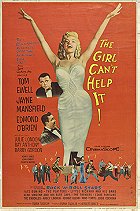
Posted : 12 years, 3 months ago on 5 March 2013 08:02
(A review of
The Girl Can't Help It (1956))
Sprinkled with a glossy coat of early rock and roll pioneers appearing for quick cameos, The Girl Can’t Help It takes aim at the music industry (namely the payola scandal), the 1950s obsession with breasts, and the deception of appearances. Moreover, with Frank Tashlin running the show, you know that the whole thing is going to be a slightly bonkers cartoon, like a “Merrie Melodies” turned flesh-and-blood.
Tom Ewell, taking his character from The Seven Year Itch to its logical and insane conclusion, plays a drunken talent manager on a depressive spiral after a bad breakup who gets roped into a mobster’s scheme to turn his pneumatic but seemingly talentless girlfriend into a star. The basic structure of the film is similar to Born Yesterday, trading out that film’s questionable view of American politics with the music industry and an assortment of musical cameos.
The film’s shiny, bright CinemaScope and Technicolor exterior can’t disguise the diseased worldview it holds dear to its heart. The music industry is presented as little more than one part organized criminal activities and one part advertising company in which stars and hit songs are engineered, talent is meaningless, and mass pop-culture is aimed squarely at the dumbest level. Edmund O’Brien’s musical performance sees a group of teenagers staring at him in dead-eyed, open-mouthed adoration.
A large chunk of the film sees O’Brien’s former gangster getting into a revised turf war with another former gangster. This time around instead of disputes about illegal gambling and money laundering, it’s about jukeboxes and getting records played. The only logical conclusion to be reached from this is that organized crime and big business as the same thing in various forms of legality.
But these aren’t the only targets that Tashlin sets about satirizing with glee. Jayne Mansfield, who else really, plays the unwitting doll to O’Brien’s gangster. Her voluptuous figure and ditzy blonde artifice disguise a woman who is happiest playing homemaker and down-playing her sex appeal. Tashlin appears to have been the only director who not only gave Mansfield material to work with, but found the right venue to highlight and support her limited talents as an actress.
But she isn’t the only character to be built upon an artifice that entraps them. Ewell’s drunken talent manager is revealed as being heartbroken after creating Julie London’s career, a drunken night has him being haunted by visions of her singing “Cry Me a River” in his home, changing outfits from room to room as he tries to escape her. We thought he was a schlep, but Ewell’s character is a secret ladies magnet. And Edmund O’Brien’s gangster chomps on cigars and talks tough, but reveals himself as happiest when indulging his secret passion as a song-and-dance man. The initial exteriors of these characters dissolve slowly as the film goes on, before finally breaking wide open during a climatic concert.
In addition, the film has plenty of fun poking around at the 1950s breast obsession. As Mansfield walks down the street a humorous sequence of events occur: ice melts, milk bottles ejaculate, a pair of glasses break, and practically every man within a three-mile radius is reduced to the wolf from a Tex Avery cartoon. Another gag sees Mansfield holding two milk bottles over her breasts while talking about how she longs for motherhood. Whether or not this is a one-note joke is up for you to decide. I found it humorous and think that it could work on a few different levels.
On a more surface level of enjoyment, The Girl Can’t Help It features some prime footage of performers like Little Richard, Julie London, Eddie Cochran, Fats Domino, the Platters, and Gene Vincent. It may be poking fun at the music industry, but Girl is also one hell of a rock and roll movie, capturing the rebellious, cartoonish spirit of the early years and blasting it writ large across the silver screen.

0 comments,
Reply to this entry
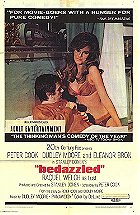
Posted : 12 years, 3 months ago on 5 March 2013 08:02
(A review of
Bedazzled)
London’s Swinging Sixties meets Faust. That’s a premise that seems like incredibly fertile ground for satire, and Peter Cook and Dudley Moore deliver the goods in Stanley Donen’s Bedazzled. While it is a hit-and-miss affair given the nature of the plot, Bedazzled charms and entertains far more than it bores.
Write that one off as the brilliance of Cook and Moore who play off of each other with the ease of a true friendship and partnership. Cook’s blasé devil is entertaining for how bored he frequently seems in his diabolical endeavors. His droll intonations of various comebacks make for a unique version of the devil. And once he starts to lose his favorite play-thing, he becomes desperate and needy for a close friend. I can’t exactly explain why, but I also found his magical words (“Julie Andrews” and “LBJ”) to be one of the funniest reoccurring gags in the film.
Moore for his part turns in an equally as engaging performance. He must go from neurotic, romantically inert wallflower to various characters as his wishes transform him into different variations of himself. But he most return to the neurotic core of his character after each of these transformation has proven unsatisfactory. He finds the right wave to surf along in this tricky role, or roles as it were.
While the bulk of the film is concerned with the seven wishes, some of which are far funnier than others, the in-between shot are no slouches themselves. Meeting the Seven Deadly Sins was a nice touch for these wrap around sequences. Raquel Welch makes the biggest impression as Lust, but who else could she possibly be? To say that she looks like the definition of a voluptuous movie star is an understatement, and the film can’t wait to undress her or have her dance around in a flimsy go-go outfit.
That dry British wit is on full display, and thank god for it. The terrible remake could have used more of it. Cook and Moore make like little impish boys taking the piss out of religion, pop culture and social conventions. Bedazzled may not be perfect, but it’s funny, intelligent and pretty fantastic. I think I’ll steal “You fill me with inertia” for use at a later time.

0 comments,
Reply to this entry
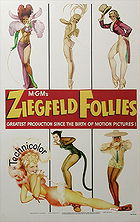
Posted : 12 years, 3 months ago on 5 March 2013 08:02
(A review of
Ziegfeld Follies (1946))
In the end it’s a bit of a bloated mess, going beyond peaks and valleys and winding up as something far more unstable. Ziegfeld Follies is consistently entertaining, and when it’s good it’s great, but the rough patches are half-formed segments which exist seemingly to just showcase more of MGM’s large wealth of talent without crafting something interesting for them to do. Thankfully the film is smart enough to be nothing more than a filmed revue and doesn’t bother with a plot.
Well, except for the introduction that has William Powell reprise his role as Ziegfeld in an opening segment glorifying his years as an entertainment maestro while he looks down from heaven. Ziegfeld takes a moment to mourn the loss of the type of entertainments that he trademarked in, and we’re then treated to a series of stop-motion recreations of some of the most famous shows and stars of the follies. While mostly cute and harmless, until a few of the puppets are placed into black face or act out questionable material for a modern audience, this opening segment is also a hint of the film’s back-patting while also applauding itself. Only MGM would imagine a scenario in which the great entertainment czars of the past get their own separate heavenly ideal.
But it’s not all bad or questionable. When Follies gets into a groove it delivers everything you could possibly want from a self-contained segment. The introductory one is quite insane, a piece of high-camp that has to be seen to be believed. It begins with Fred Astaire, a large ensemble of chorus girls and Cyd Charisse performing to “Here’s to the Girls.” Out of nowhere comes Lucille Ball looking glamorous and lovely. Ball pulls out a whip, and things only get weirder from there as a group of dancers dressed up as cats are suddenly tamed by Ball cracking the whip and engaging in some minor choreography. Virginia O’Brien gallops in on a white horse and delivers a sarcastic, horny rebuttal called “Bring on Those Wonderful Men.” As a primer to the rest of the proceedings, it’s pretty fantastic and overloaded with kitsch and avant-garde stage design.
Esther Williams moves beautifully and looks gorgeous in her water ballet, but it’s a half-baked endeavor. It feels like it was added in purely to appease fans of her water-based musicals. The two opera segments are DOA and drag the movie down more than anything else. The same could be said of the numerous comedic sketches which go on for too long. Red Skelton tries to get laughs out of a premise which drags on longer than necessary. And maybe Fanny Brice’s charms are lost upon me, but I just didn’t find her particularly funny. I did think that her segment had a lot of potential, but her shtick wore thin quickly. The other two comedic sketches are utterly forgettable and pad out an already long movie.
But there is a strong set of musical numbers in Ziegfeld Follies that makes it worth watching, aside from all of the craft and talent on display. “Love” features Lena Horne singing the standard torch song in a Caribbean setting. Horne delivers her typically assertive, strong and sensual performance, and the costumes, lighting, makeup and color scheme all seem to have dovetailed together to make her look at her most intoxicatingly glamorous and beautiful.
“Interview with a great star” sees Judy Garland having some fun with both the nature of studio-crafted dramatic stars and a persona like Greer Garson, someone who only did serious and dramatically important parts/movies. Garland gives in to every diva affectation that she can think of, and appears to be having a ball sending up some of her fellow MGM stars. Few performers could command attention and the screen with the minimalist of movements and flourishes, but Garland was one of them.
The two dance numbers from Fred Astaire and Lucille Bremer may have their faults, but there’s an elegance and beauty to each of them. The first sees Astaire as a jewel thief trying to con a princess out of her extravagant jewelry. The rotating floors, stylized sets and romance that Bremer and Astaire are able to conjure up make up for the lack of a satisfying conclusion. “Limehouse Blues” is more problematic as it gives in to stereotypical iconography about Asians. Yet when the segment takes off into a fantasy world and sees the two stars dancing around with fans in an expressionistic oriental landscape, it’s pure magic. The less said about Astaire and Bremer in yellow-face makeup the better.
“The Babbitt and the Bromside” may not live up to the expectations of watching Fred Astaire and Gene Kelly perform together in a scene, but it’s the only one in existence. And if it doesn’t match-up to something we could have imagined, nothing ever will, honestly. But Astaire and Kelly give it their all, and it’s amusing enough.
The only reason to watch the final segment is to see Cyd Charisse dance through several large soap bubbles. Her grace and athleticism as a ballerina allows her to effortlessly, or that’s how it appears, glide from one large group of bubbles to another with relatively little of them attached to her. It’s oddly hypnotic, until Kathryn Grayson comes out and sings “There’s Beauty Everywhere” in her trill.
Ziegfeld Follies has much to recommend about it, but this does feel like a movie that is best left to discover in chunks. Perhaps by looking up the full list of segments online and seeing if you can find them on YouTube. I know “Love” and a few others are already on there. But if you want to commit to the full experience, and it is an experience, well, there are worse ways to spend nearly two hours.

0 comments,
Reply to this entry
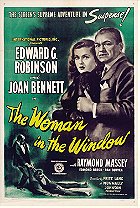
Posted : 12 years, 3 months ago on 5 March 2013 08:02
(A review of
The Woman in the Window)
Here’s a film with a dream-like look that’s really more like machinery greasing for Scarlet Street. Nothing in The Woman in the Window is bad, really, but the ending is a cheat and nullifies everything that had gone before it. This bait-and-switch ending also leaves the film, stylistically noir in all the right places even if it never wears these tropes too comfortably, on a jokey final note.
The Woman in the Window starts off with a middle-aged college professor ruminating on adventurousness, a path never taken, and the portrait of a beautiful woman hanging in the shop window next door to their club. He then proceeds to fall asleep in the club. It’s a bit of a sludge introduction to wade through, but once he meets the model from the portrait, murders her lover in an act of defense and proceeds to crumble under his guilt and her emotional manipulations, the film picks up speed and our interest.
Edward G. Robinson and Joan Bennett do solid, admirable work in their parts, and Raymond Massey provides a nice flair in a key supporting role. But the big reveal in The Woman in the Window, which I won’t reveal here, turns a harrowing trip through one man’s degradation and indulgence in his secretly violent and brutal sides becomes defanged. The reveal is done with a nice series of camera tricks, but it left me cold to the film as a whole. This is a film that could have been among the most potent and stylish of noirs, but it ends up being a solidly made crime-tinged melodrama.

0 comments,
Reply to this entry

Posted : 12 years, 4 months ago on 4 March 2013 07:46
(A review of
Hail the Conquering Hero (1944))
Preston Sturges burned bright in the 1940s. No other writer-director-producer could touch him when it came to satirizing American culture and crafting films that are delicious desserts with tart notes quite like him. The Lady Eve, Sullivan’s Travels and Unfaithfully Yours prove his genius. Hail the Conquering Hero reminds us of it.
Hometown glory and patriotism run amuck in Americana are the main courses in his consistently smart, acerbic and wildly funny script. Woodrow Lafayette Pershing Truesmith, what a name!, is the nerdy son of an acclaimed war hero. Woodrow is a man who has eternally lived in his father’s shadow, growing up with the oft retold stories of his father’s heroism and daring. So, naturally, when World War II breaks out, he goes about enlisting.
The problem is that he’s unfit for service – his allergies being one of the main reasons that this nerdy schlub can’t cut in any branch of military service. Disgraced by his poor constitution, he hides out and writes letters back home to his mother about his adventures in combat. Isn’t it better to lie than go home and tell her the truth about how he’ll never be his father’s son? While drinking away his guilt and depression one night he meets a group of Marine Corps returning home. They take pity on him (and his plight), and concoct an elaborate story to tell him mother about all of the adventures and heroic deeds he’s done while serving overseas.
From this basic premise it’s not hard to see where and when the satirical humor will come to the surface. And Sturges doesn’t disappoint. The shell-shocked, slightly crazed group of veterans works as a Greek chorus, encouraging the lie(s) not just for Woodrow’s sake but for the comfort it gives his mother and the town at large. Conquering Hero takes our culture’s tendency to exalt returning soldiers to the level of demi-god status and flips the script in a smart way. The value of honesty in this film is all purely relative. Sure Woodrow isn’t really a hero, but look at the comfort, pride and love it gives his mother to know that her son did something.
And in true Sturges fashion, he brilliantly casts the leads with character actors and minor stars that could never be properly utilized by anybody else. Eddie Bracken delivers a great comedic performance as a man who seems his moral compassion becomes entangled as he tries valiantly to remember what story is true and which is not. Bracken’s neurotic decay throughout the film as he wins back his old girlfriend, becomes the town’s mayoral candidate and sees his stock rise in the town’s eyes is filled with a kind of manic energy that can dip into overacting so easily. But Bracken manages to keep his character grounded and knows when to reign in the goofy faces and limb flailing. And William Demarest gets the juiciest role in the whole film as the leader of the Marines who leads the charge for the whole charade. He works as an inverse Jiminy Cricket and his cracked moralizing is both hilarious and stingingly true. If the legend brings people together and makes them feel better, what’s the harm in it?
Given that this film was released at the height of the Production Code’s strict rule enforcement it comes as a large surprise how much anti-hero worship that Sturges managed to get passed through. The way the film takes on the uncritical masses that hear a story, believe it and elevate someone to the platform of demi-god is pretty remarkable. It runs as smooth as clockwork, complete with his trademark overlapping dialog and insanely fast pacing. While I think the ending is a little soft, it doesn’t mar Hail the Conquering Hero in any way. And if you want proof of Sturges greatness, consider this: in 1944 he was nominated against himself (for this film and The Miracle at Morgan’s Creek) for the Best Original Screenplay Academy Award. Not many people can claim that bit of trivia.

0 comments,
Reply to this entry
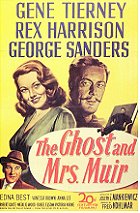
Posted : 12 years, 4 months ago on 4 March 2013 07:46
(A review of
The Ghost and Mrs. Muir)
Romantic delirium becomes one woman’s preferred living space in The Ghost & Mrs. Muir. On a surface level the film seems to be obviously about a ghost haunting the seaside manor that a widow moves in to, and as they clash and learn to live with each other, they fall into some variation of love. Deeper still, and this is a tribute to Gene Tierney’s lovely performance, the movie takes on a sadder and somber tone – is the ghost real, or just a figment of Mrs. Muir’s imagination who she has dressed up in the personage of the former owner? The film never provides a clean-cut answer, but the duality of readings is a nice touch to what could be very sudsy material.
What’s most interesting, apart from the perfect score by Bernard Hermann and the by turns moody and romantic cinematography by Charles Lang Jr., is the titular heroine. A woman who feels nothing much in particular about her dead husband, or the very act that brought her daughter into the world. Instead, this gentile woman, a lady of leisure and breeding if ever there was one, wants a rough around the edges, salt of the earth type to swing into her life and teach her all about erotic awakenings and soothing his beastly edges. So there appears the ghost, a former sea captain played by Rex Harrison in full-on bombastic, profane yet sexy mode. It’s not hard to see why she would prefer to live out her days with this imagined man, particularly when things go south any time she tries to forge or create a real romance.
There’s a strong sense of romantic ache, isolation and sadness creeping in the edges and shadows of The Ghost and Mrs. Muir. And that gentle quake is what gives the film a spark that makes it so unique. This wistful elegance combined with strong performances from Tierney and Harrison as a fire-and-ice couple make this worth watching. Ethereal love has never quite looked so good.

0 comments,
Reply to this entry
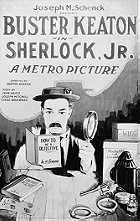
Posted : 12 years, 4 months ago on 26 February 2013 10:16
(A review of
Sherlock, Jr.)
Keaton’s learning curve was immensely quick. Only a year after Our Hospitality showed his artistic triumphs in the infant stages, Sherlock Jr. comes out and demonstrates that he is now at the top of his craft. At roughly forty-five minutes in length, which is both too brief and just right, Sherlock Jr. may just, objectively speaking, be the greatest film in all of his filmography.
It’s certainly the most avant-garde. While many of his films may dip their toes into surrealistic images or make you think you’re hallucinating what you’re seeing, this one actually is a surrealistic, hallucinatory journey through the imagination. It’s also a love letter to cinema in many ways.
Keaton is a love-sick film projectionist who daydreams of becoming a world class detective. After being incorrectly framed as a thief by his romantic rival, Keaton falls asleep in the booth and begins his whimsical (dream) journey. A still outstanding bit of camera trickery sees Keaton’s ghostly dream-version rise out of his still sleeping body and walk into the theater. He continues walking until he has actually become one with the running bits of stock film footage on the big screen.
In this film/dream world, he is a well-respected detective and goes on to solve an elaborate mystery. This film/dream world is a testament to the power of the imagination and to the cinema. Not only is he able to right the wrongs of his real life, but he can escape from reality and become whoever he wishes to be. Has that not been the power and magic of reading, theater and film since the beginning?
Keaton has created a wonderful visual poetry with his too numerous to mention memorable gags in this film. The lockstep behind his rival, the moment he enters the screen, a pool game that doesn’t go as planned, a window escape that involves a costume change, or a moment in which he appears to jump into the body of his friend. They’re each astounding and I could write paragraphs upon paragraphs about how brilliant they are.
Sherlock Jr. is the kind of movie that ignites the Keaton vs. Chaplin debate. They’re both brilliant (for the record, I fall into the Chaplin camp), and if any movie could convert me to the other’s camp, it is this one. The tremendous economy of the storytelling leaves no room for lags or quiet moments. The gags are brilliant, the stunts are memorable, and Keaton’s three-in-one character/performance is a masterclass in underplaying for effect. It’s also fairly disarming to realize that even this early into cinema’s life artists were creating films which reflected on the relationship between medium and viewer. And to think a movie like The General was still just around the corner. Amazing.

0 comments,
Reply to this entry
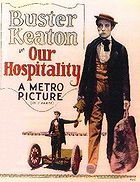
Posted : 12 years, 4 months ago on 26 February 2013 10:16
(A review of
Our Hospitality (1923))
If the Hatfields and McCoys rivalry doesn’t sound like ripe ground for comedic possibilities then you clearly aren’t Buster Keaton. The great stone faced comedian who met every challenge with remarked indifference and performed death-defying stunts with no emotional investment. Our Hospitality may not be the greatest of Keaton’s film, but its unique in that it allows us a look at an artist figuring out how to navigate the world of feature-length productions.
It’s an embryonic glimpse of the genius and visual poetry that would flow out of him a few years later. The opening prologue is pure melodrama of the silent period. Our hero’s father and his main rival engage in a pistol duel, his father dies, and his mother freaks and relocates to New York where he grows up blissfully unaware of the long-standing blood feud.
Flash forward and now our hero is twenty-one and on a return journey to reclaim the family estate. And the film is divided into, roughly, four chunks. The prologue, the train journey back, a dinner date that goes wrong and a madcap chase filled with Keaton’s typically crazy stunts. Each of these segments, minus the prologue, feels too long and bloated, and like the film would have been better suited to an exceptionally amazing short. What we have is an almost great movie that has scenes and reoccurring jokes which go on for a bit too long.
The train journey in particular seems to go on and on and on. It’s cute and charming at first, but I was ready for it to reach the station so we could move on to something else. Naturally, he meets and falls in love with a girl along the train journey, and she turns out to be the daughter of his family’s sworn enemy. Hatfields and McCoys reimagined as a Romeo and Juliet stand-in, it’s not terribly original, but Keaton does get in a few good dings along the way. He knows that as long as he’s a guest in their home, as southern gentlemen, they’ll be incapable of harming him the entire time he stays, so he keeps finding more outrageous and elaborate reasons to prolong his stay.
The climax is a never-ending chase which comes to a head with Keaton dangling over a waterfall on a tiny branch, fighting off the white rapids and reaching shore for his happily ever after. It’s exhilarating and still awe-inspiring despite 90 years separating it from us and the time of its creation. It is arguably one of the indelible images and greatest moments in all of cinema.
In Our Hospitality, Keaton hasn’t quite figured out how to manage the stunt work and plotting of an extended running time in this film, but all of his hallmarks are there. In a short period of time he’d go on to give us Sherlock, Jr. and The General, so Hospitality’s narrative shortcomings are more than forgiven since this is a glimpse of an artist figuring out the balancing act of a medium he’d go on to master.

0 comments,
Reply to this entry
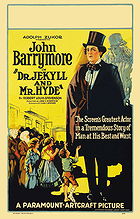
Posted : 12 years, 4 months ago on 26 February 2013 07:52
(A review of
Dr. Jekyll and Mr. Hyde)
If there is any classic figure from horror novels which actors aspire to play, I suspect that it is Dr. Jekyll and his animalistic id Mr. Hyde. Not only does the character allow for an actor to portray two distinct personas, but Mr. Hyde allows them indulge in both playing dark and naughty, and masking themselves underneath layers of makeup and costuming. It’s the chance to lose all semblance of themself in a role, and that’s probably why great cinema icons like Spencer Tracy and John Barrymore have tackled the role.
This 1920 version may not be perfect, but Barrymore’s central performance gives the film a great boost and goes a long way to making it a near-masterpiece. Sometimes great acting can sell a project better than anything else on its own. If Dreyer didn’t have Falconetti as the center of his Passion of Joan of Arc, that filmed would have buckled under its own adventurous artistry and probably wouldn’t be remembered as the great classic that it is.
A similar thing is going on here with Barrymore’s take on the Robert Louis Stevenson story. Director John S. Robertson is no Dreyer though, so he never creates as much atmosphere or visual splendor to work in tandem with the bravura performance that his star is giving, but he also never sinks the film. He smartly knows when to back off and let Barrymore go in fits of wild abandon, and he does manage to create two striking and memorably disturbed transformation scenes.
The first transformation scene has Barrymore twisting and contorting his body and facial muscles into Hyde without the aid of makeup. There is a cut to him appearing in full regalia, but that image doesn’t linger or unnerve as much as the sight of Barrymore’s actorly fits. It’s practically early-method in its intensity and commitment as he rolls his eyes to the back of his head, reaches out to the air and slams his body down on the floor. It’s riveting and alarming at how little regard is being kept for his body’s well-being as he risks injury to sell us on the idea of Hyde’s takeover.
The other transformation scene is more complicated and a vastly trickier bit of editing. As Jekyll sleeps in his bed, a giant white spider with the head of Hyde comes out from underneath his bed, crawls on top of him and they merge into one being for a brief second. And then Hyde is lying in the bed. The special effects work holds up after all of these years, and Hyde’s malevolent smile as he takes over sells the scene.
The duality at the center of story is typically simplified as two archetypes battling over dominance. Jekyll here is all good, he borderlines on the saintly in fact. He isn’t just a respected doctor, but a doctor who runs a free clinic for the poor. And his transformation into the monstrous Hyde is sold by the actor’s leering looks and willingness to look more like an animal than a man in his body carriage and physical gestures. His smile and eyes frequently give the impression of impending sexual violence while dressed up as the hunchbacked, balding, tattered and clawed Hyde.
The only thing that could have made Dr. Jekyll and Mr. Hyde better was a director who could match wits and imagination with Barrymore. I wonder what could have happened if a German expressionist had taken the project into darker, more cerebral and surreal territory. It’s a little muzzled compared to a work like The Cabinet of Dr. Caligari or Nosferatu, but as a star vehicle, it soars. And it’s never less than captivating at every twist and turn.

0 comments,
Reply to this entry
 Login
Login
 Home
Home 95 Lists
95 Lists 1531 Reviews
1531 Reviews Collections
Collections
 0 comments,
0 comments, 







